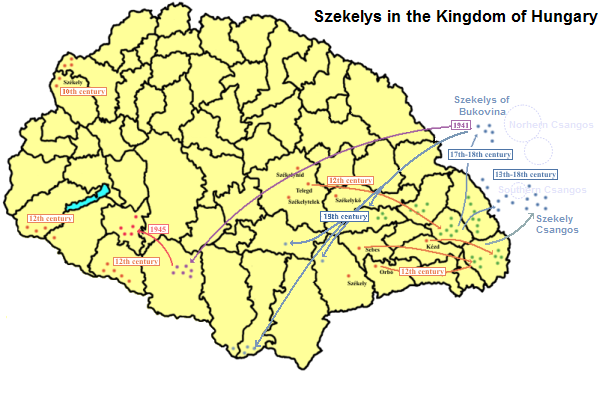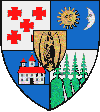|
Unirea, Alba
Unirea, previously ''Vințu de Sus'' ( hu, Felvinc, german: Oberwinz), is a commune located in the north-east of Alba County, Transylvania, Romania. It is composed of six villages: Ciugudu de Jos (''Alfüged''), Ciugudu de Sus (''Felfüged''), Dumbrava (''Dombró''), Inoc (''Inakfalva''), Măhăceni (''Aranyosmohács'') and Unirea. Geography Unirea is located on the Mureș River, in the north-east corner of Alba County, approximately 50 km from the county capital, Alba Iulia, and 20 km from the town of Turda, on the Romanian National Road DN1. The commune is bordered by Cluj County in the north and west, the town of Ocna Mureș in the east, and the commune of Mirăslău in the south. History From the late 13th century until 1876 the centre of today's commune was the administrative centre of the Aranyosszék region of Transylvania. In 1876, when the administrative system of the Kingdom of Hungary was reorganised, it became part of Torda-Aranyos county. After th ... [...More Info...] [...Related Items...] OR: [Wikipedia] [Google] [Baidu] |
Commune In Romania
A commune (''comună'' in Romanian) is the lowest level of administrative subdivision in Romania. There are 2,686 communes in Romania. The commune is the rural subdivision of a county. Urban areas, such as towns and cities within a county, are given the status of ''city'' or ''municipality A municipality is usually a single administrative division having municipal corporation, corporate status and powers of self-government or jurisdiction as granted by national and regional laws to which it is subordinate. The term ''municipality ...''. In principle, a commune can contain any size population, but in practice, when a commune becomes relatively urbanised and exceeds approximately 10,000 residents, it is usually granted city status. Although cities are on the same administrative level as communes, their local governments are structured in a way that gives them more power. Some urban or semi-urban areas of fewer than 10,000 inhabitants have also been given city status. Each ... [...More Info...] [...Related Items...] OR: [Wikipedia] [Google] [Baidu] |
Turda County
Turda County was a county (Romanian: ''județ'') in the Kingdom of Romania, as successor to Torda-Aranyos County in Austria-Hungary. Its capital was Turda. Geography Turda County covered and was located in central western part of Greater Romania, in the western part of Transylvania. Its borders were as follows: to the north, Cluj County; to the west the counties of Bihor and Arad; to the south, the counties of Hunedoara and Alba; and to the east the counties of Târnava Mică and Mureș. Currently, the territory that comprised the greater part of Turda County is now part of Cluj County, Mureș County, and Alba County. Historical County Prior to World War I, the territory of the county belonged to Austria-Hungary and was almost identical with the Torda-Aranyos County of the Kingdom of Hungary. The territory was transferred to Romania from Hungary as successor state to Austria-Hungary in 1920 under the Treaty of Trianon. The county's Romanian name became Turda-Arieș County, i ... [...More Info...] [...Related Items...] OR: [Wikipedia] [Google] [Baidu] |
Leon Șușman
Leon Șușman (June 10, 1910 – July 19, 1957) was a member of the fascist paramilitary organization the Iron Guard who, following the Soviet occupation of Romania and establishment of the Romanian People's Republic, became the leader of an anti-communist paramilitary group in the Apuseni Mountains. Șușman was born in Măhăceni, Alba County on June 10, 1910, in a family of Greek-Catholic peasants. After graduating with a law degree from the University of Cluj, he joined the Iron Guard. In 1941 he was sentenced to 10 years in prison for his participation in the Legionnaires' rebellion and Bucharest pogrom; however, he escaped capture and fled to the Apuseni Mountains. In 1945, following an agreement between Iron Guard leader Nicolae Petrașcu and Interior Minister Teohari Georgescu which granted Iron Guard members amnesty in exchange for turning in their weapons, Șușman returned to civilian life and practiced law in Ocna Mureș; he did so until May 15, 1948, when the Commu ... [...More Info...] [...Related Items...] OR: [Wikipedia] [Google] [Baidu] |
Coriolan Suciu
Coriolan Suciu (19 December 1895–27 January 1967) was an Austro-Hungarian-born Romanian teacher and historian, and a priest in the Romanian Greek-Catholic Church. Biography Born in Ciugudu de Jos, Alba County, in the Transylvania region, he attended gymnasium from 1906 to 1914 and studied theology from 1914 to 1917 in nearby Blaj. He then studied history and Latin at Budapest and Cluj from 1917 to 1919, attended specialty courses in Paris from 1921 to 1922 and, following the union of Transylvania with Romania and the creation of Superior Dacia University, obtained a doctorate there in 1922. In Blaj, he taught at Saint Basil High School from 1919, was director of the apprentices' school from 1929 to 1937, becoming head of the normal school in 1937 and holding a similar position at Saint Basil from 1941 to 1945. Between 1945 and 1956, he worked as a professor at Inocențiu Micu Klein High School in Cluj, where for a time he served as director. This period saw the onset of a ... [...More Info...] [...Related Items...] OR: [Wikipedia] [Google] [Baidu] |
Székelys
The Székelys (, Székely runes: 𐳥𐳋𐳓𐳉𐳗), also referred to as Szeklers,; ro, secui; german: Szekler; la, Siculi; sr, Секељи, Sekelji; sk, Sikuli are a Hungarian subgroup living mostly in the Székely Land in Romania. A significant population descending from the Székelys of Bukovina lives in Tolna and Baranya counties in Hungary and certain districts of Vojvodina, Serbia. In the Middle Ages, the Székelys played a role in the defense of the Kingdom of Hungary against the Ottomans in their posture as guards of the eastern border. With the Treaty of Trianon of 1920, Transylvania (including the Székely Land) became part of Romania, and the Székely population was a target of Romanianization efforts. In 1952, during the communist rule of Romania, the former counties with the highest concentration of Székely population – Mureș, Odorhei, Ciuc, and Trei Scaune – were legally designated as the Magyar Autonomous Region. It was superseded in ... [...More Info...] [...Related Items...] OR: [Wikipedia] [Google] [Baidu] |
Hungarian Minority In Romania
The Hungarian minority of Romania ( hu, Romániai magyarok; ro, maghiarii din România) is the largest ethnic minority in Romania, consisting of 1,227,623 people and making up 6.1% of the total population, according to the 2011 Romanian census, the second last recorded in the country's history. Most ethnic Hungarians of Romania live in areas that were, before the 1920 Treaty of Trianon, parts of Hungary. Encompassed in a region known as Transylvania, the most prominent of these areas is known generally as Székely Land ( ro, Ținutul Secuiesc, links=no; hu, Székelyföld, links=no), where Hungarians comprise the majority of the population. Transylvania also includes the historic regions of Banat, Crișana and Maramureș. There are forty-one counties of Romania; Hungarians form a large majority of the population in the counties of Harghita (85.21%) and Covasna (73.74%), and a large percentage in Mureș (38.09%), Satu Mare (34.65%), Bihor (25.27%), Sălaj (23.35%), and C ... [...More Info...] [...Related Items...] OR: [Wikipedia] [Google] [Baidu] |
Roma Minority In Romania
Romani people (Roma; Romi, traditionally '' Țigani'', (often called "Gypsies" though this term is considered a slur) constitute one of Romania's largest minorities. According to the 2011 census, their number was 621.573 people or 3.3% of the total population, being the second-largest ethnic minority in Romania after Hungarians. There are different estimates about the size of the total population of people with Romani ancestry in Romania, varying from 4.6 per cent to over 10 percent of the population, because many people of Romani descent do not declare themselves Romani. For example, the Council of Europe estimates that approximately 1.85 million Roma live in Romania, a figure equivalent to 8.32% of the population. Origins The Romani people originate from northern India, presumably from the northwestern Indian regions such as Rajasthan and Punjab. The linguistic evidence has indisputably shown that roots of Romani language lie in India: the language has grammatical character ... [...More Info...] [...Related Items...] OR: [Wikipedia] [Google] [Baidu] |
Romanians
The Romanians ( ro, români, ; dated exonym '' Vlachs'') are a Romance-speaking ethnic group. Sharing a common Romanian culture and ancestry, and speaking the Romanian language, they live primarily in Romania and Moldova. The 2011 Romanian census found that just under 89% of Romania's citizens identified themselves as ethnic Romanians. In one interpretation of the 1989 census results in Moldova, the majority of Moldovans were counted as ethnic Romanians.''Ethnic Groups Worldwide: A Ready Reference Handbook By'' David Levinson, Published 1998 – Greenwood Publishing Group.At the time of the 1989 census, Moldova's total population was 4,335,400. The largest nationality in the republic, ethnic Romanians, numbered 2,795,000 persons, accounting for 64.5 percent of the population. Source U.S. Library of Congress "however it is one interpretation of census data results. The subject of Moldovan vs Romanian ethnicity touches upon the sensitive topic ofMoldova's national i ... [...More Info...] [...Related Items...] OR: [Wikipedia] [Google] [Baidu] |
Census
A census is the procedure of systematically acquiring, recording and calculating information about the members of a given population. This term is used mostly in connection with national population and housing censuses; other common censuses include censuses of agriculture, traditional culture, business, supplies, and traffic censuses. The United Nations (UN) defines the essential features of population and housing censuses as "individual enumeration, universality within a defined territory, simultaneity and defined periodicity", and recommends that population censuses be taken at least every ten years. UN recommendations also cover census topics to be collected, official definitions, classifications and other useful information to co-ordinate international practices. The UN's Food and Agriculture Organization (FAO), in turn, defines the census of agriculture as "a statistical operation for collecting, processing and disseminating data on the structure of agriculture, coverin ... [...More Info...] [...Related Items...] OR: [Wikipedia] [Google] [Baidu] |
Miercurea-Ciuc
Miercurea Ciuc (; hu, Csíkszereda, ; german: Szeklerburg) is the county seat of Harghita County, Romania. It lies in the Székely Land, a mainly Hungarian-speaking ethno-cultural region in eastern Transylvania, and is situated in the Olt River valley. The city administers three villages: * Ciba / Csiba * Harghita-Băi / Hargita-fürdő * Jigodin-Băi / Zsögöd-fürdő, including Jigodin / Csíkzsögöd Demographics According to the census of 2011, there were 37,980 people living in the city. Of this population, 81.39% are ethnic Hungarians, while 17.4% are ethnic Romanians, 0.9% are ethnic Romani, and 0.33% declare other nationalities. According to the census of 2002, there were 42,029 people living in the city. Of this population, 81.75% are ethnic Hungarians, while 17.3% are ethnic Romanians, 0.62% are ethnic Romani and 0.33% declare other nationalities. ''Demographic movements according to census data:'' Colors= id:lightgrey value:gray(0.9) id:darkgrey value: ... [...More Info...] [...Related Items...] OR: [Wikipedia] [Google] [Baidu] |
Middle Ages
In the history of Europe, the Middle Ages or medieval period lasted approximately from the late 5th to the late 15th centuries, similar to the post-classical period of global history. It began with the fall of the Western Roman Empire and transitioned into the Renaissance and the Age of Discovery. The Middle Ages is the middle period of the three traditional divisions of Western history: classical antiquity, the medieval period, and the modern period. The medieval period is itself subdivided into the Early Early may refer to: History * The beginning or oldest part of a defined historical period, as opposed to middle or late periods, e.g.: ** Early Christianity ** Early modern Europe Places in the United States * Early, Iowa * Early, Texas * Early ..., High Middle Ages, High, and Late Middle Ages. Population decline, counterurbanisation, the collapse of centralized authority, invasions, and mass migrations of tribes, which had begun in late antiquity, continued i ... [...More Info...] [...Related Items...] OR: [Wikipedia] [Google] [Baidu] |






